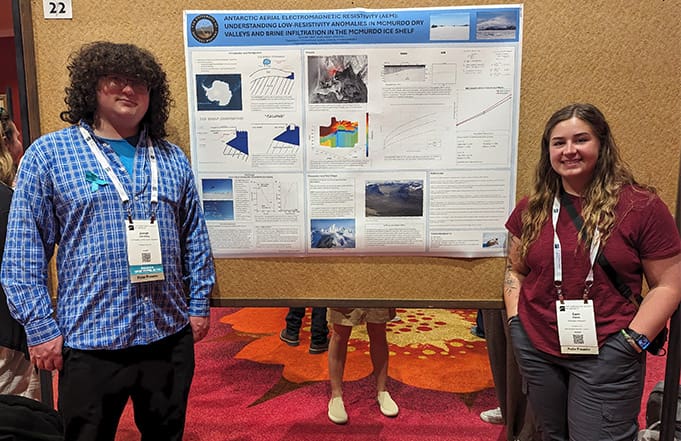June 27, 2024
University of Montana Western undergraduate students Samantha (Sam) Haak and Jonah Lindsey recently presented their research at the Geological Society of America (GSA) meeting in Spokane, WA. Their poster, titled "Antarctic Aerial Electromagnetic Resistivity (AEM): Understanding Low-Resistivity Anomalies in the McMurdo Dry Valleys and Brine Infiltration in the McMurdo Ice Shelf," provided new insights into the dynamics of Antarctic ice shelves.

Haak graduated in the spring of 2024 with a Bachelor’s degree in Environmental Science with a focus in Geology, and Lindsey is a senior majoring in Biology with a focus in Ecology. The two of them teamed up under the guidance of Dr. Neil Foley, Professor in UMW’s Environmental Science Department, and conducted National Science Foundation (NSF)-funded research that revealed the McMurdo Ice Shelf (MIS) contains up to 17% brine, highlighting significant saltwater infiltration into the ice shelf.
Ice shelves, formed when glaciers descend from land and float when they reach the ocean, are crucial components of the Antarctic landscape. They are common around the periphery of Antarctica and calve off or break off to become massive icebergs. Haak and Lindsey’s work shows that seawater can enter this calving front and percolate through pore space for dozens of kilometers.
Using electromagnetic (EM) resistivity data, Haak and Lindsey mapped the extent of the brine. Resistivity is a measure of how difficult it is for electrical current to pass through a material. Pure snow and ice exhibit very high resistivity, whereas saltwater has low resistivity. This contrast allowed them to identify regions with low-resistivity brines.
Understanding the extent and mechanism of brine infiltration is crucial because it increases the ice shelf’s weight, much like how a wet sponge is heavier than a dry one. This increased loading of the ice shelf makes it more susceptible to calving. While calving is a natural process that removes ice from the shelf, accelerated calving, where more ice is lost than replaced, could contribute to sea level rise as glacier ice flows more rapidly to the sea. This accelerated calving also has short-term repercussions as the stability of the MIS is particularly important because it hosts runways that serve the United States Antarctica Program at McMurdo Station, a nearby logistical hub for the whole continent and many affiliated national Antarctic Programs.
Haak and Lindsey correlated their measurements with past researchers’ work. Their use of EM resistivity is novel in this setting, but it is a useful complement to different techniques used by past researchers, notably Ice Penetrating Radar. Their work is useful for mapping extents and thickness of brines, while radar is useful for high-resolution cross-sections.
“Presenting research at conferences is crucial for knowledge dissemination, training, and networking,” said Dr. Foley. “This experience allowed Sam and Jonah to engage with professionals from academia, state agencies, and industry. Their work represents the culmination of their education, applying skills from physics, math, and geology, and learning new ones like Matlab programming.”
“The opportunity to present our research at the Geological Society of America conference was phenomenal. UMW prepared me well for public speaking and presenting through classes and opportunities to connect with local agencies. I am grateful for my education from Western and excited for the next chapter of my life,” said Haak.
The University of Montana Western celebrates Haak and Lindsey’s achievements, reflecting the institution’s commitment to experiential education.
For more information on the University of Montana Western and its programs, visit www.umwestern.edu or call 877-683-7331.